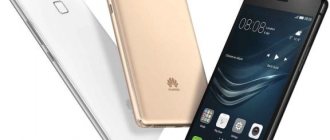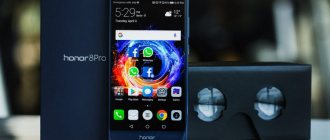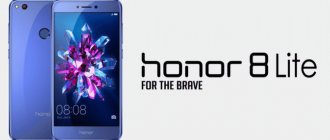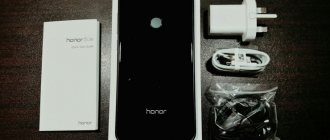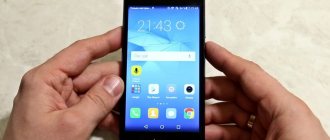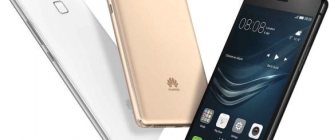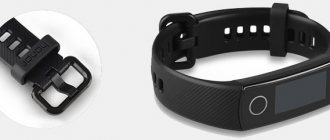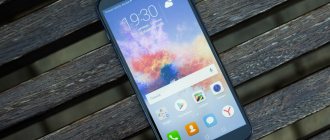Price and main characteristics
Honor 6C Pro is another offshoot of the sixth generation of the line, the first model of which was released quite a long time ago. The average cost of a device in Russian retail chains is 11,000 rubles.
Specifications:
• display: 5.2”, IPS HD 1280×720 px (294 ppi); • processor: MediaTek MT6750 (1.5 GHz) + video accelerator ARM Mali-T860; • RAM: 3 GB; • internal memory: 32 GB + support for microSDXC cards up to 128 GB; • camera: main – 13 MP, front – 8 MP; • communication: Wi-Fi 802.11 a/b/g/n, Bluetooth 4.1, GPS, A-GPS, Glonass; • battery: 2900 mAh. • Dimensions: 147.9 x 73.2 x 7.65 mm; • Weight: 145 g.
The technical characteristics of the gadget are rather unremarkable, but such a low price makes you think about buying the 6C Pro. The smartphone does not have many competitors with a similar hardware platform and the same screen diagonal.
Detailed technical specifications
Make and model
Make and model of the device, and alternative names (if any).
| Brand Device manufacturer company. | Huawei |
| Model Device name. | Honor 6C Pro |
| Alternative names Other model names, if available. Sometimes the model is called differently, depending on the country or because of popular nicknames. | JMM-L22 |
Design
Appearance of the device including dimensions, weight, volume, colors and materials.
| Width The horizontal side of the device when used in standard orientation. | 73.2 mm (millimeters) |
| Height The vertical side of the device when used in standard orientation. | 147.9 mm (millimeters) |
| Thickness The cross-sectional size of the device. | 7.65 mm (millimeters) |
| Weight How much does the device weigh excluding the case, SIM and memory cards and other additional elements. | 145 g (grams) |
| Volume Approximate value calculated using the formula: length times width times height. | 82.82 cm³ (cubic centimeters) |
| Colors What colors is the device available in? | Black Blue Golden |
| Housing materials What materials is the body made of? | Metal |
System on a Chip (SoC)
A system on a chip, a single-chip system (System on a Chip, SoC) is when several systems performing different device functions are connected on one chip.
| System on a Chip (SoC) A single-chip system that contains components such as a processor, graphics accelerator, memory units, communication interfaces, etc., as well as software for the operation of the system. | MediaTek MT6750 |
Central processing unit (CPU)
| Central processing unit (CPU) The main component of the device is responsible for calculations and data processing. | 4x 1.5 GHz ARM Cortex-A53, 4x 1.0 GHz ARM Cortex-A53 |
| Technical process What technological process is used to make the chip? The smaller the process technology, the better - the chips consume less power and generate less heat. | 28 nm (nanometers) |
| Processor size Processor capacity is a parameter that indicates how many bits of data a processor register processes in 1 clock cycle. This is usually 32 or 64 bits. | 64 bit |
| Instruction Set Architecture Instruction set architecture (ISA) is a programmable part of the microprocessor core used by software to control the operation of the processor. | ARMv8-A |
| Number of processor cores The processor can be either single-core or multi-core. The performance of the processor depends on the number of cores (threads). The more cores working simultaneously, the higher the power consumption, so in mobile devices all cores are used only under high load. | 8 |
| CPU clock speed Clock speed is the number of operations per second that a processor or its core can achieve. The higher the frequency, the higher the overall performance of the device, but performance also depends on the processor architecture and the number of cores. | 1500 MHz (megahertz) |
Graphics Processing Unit (GPU)
| Graphics Processing Unit (GPU) The graphics processing unit (GPU) is used to process and display graphics - 3D effects, games, interfaces and other visual elements. Due to the pipeline architecture, the GPU is many times more efficient in graphics processing than the processor. | ARM Mali-T860 MP2 |
| Number of GPU cores Similar to a processor, a GPU can have one core or several. The number of cores (threads) determines the performance and amount of information processed. The more cores, the better. | 2 |
| GPU clock speed Clock speed is the number of operations per second that the GPU or its core is capable of achieving. The higher the frequency, the higher the speed of the processor, and therefore the number of tasks it can solve. | 520 MHz (megahertz) |
Random access memory (RAM)
| Amount of random access memory (RAM) RAM (Random Access Memory, RAM, RAM) is temporary memory (works only while the device is running), which stores data and code for the operational operation of programs and applications. The more RAM, the more programs you can run simultaneously without loss of performance (there will be fewer “brakes”). | 3 GB (gigabytes) |
| Type of random access memory (RAM) Information about the type of RAM used by the device. | LPDDR3 |
| Number of RAM channels 1 is a single-channel RAM operating mode, basic, when 1 memory module is used. 2 is already a two-channel mode - a mode of parallel operation of 2 modules or pairs of modules, memory channels - this mode is 2 times faster than a single-channel one. 3 – three-channel mode is 3 times faster than single-channel mode. | Single channel |
| RAM frequency The frequency of RAM determines the speed of RAM, or rather the speed of data transfer and reception. In theory, the higher the frequency, the more powerful the RAM. | 667 MHz (megahertz) |
Built-in memory
Most mobile devices have built-in Flash memory, which is used as a storage for system data, the operating system, as well as user data - photos, videos, recordings and much more.
| Built-in memory capacity The higher the amount of built-in memory, the more games, programs, music, videos and your other files will fit in the device, especially the amount of memory is important when the device does not support memory cards. | 32 GB (gigabytes) |
Operating system
A mobile operating system (OS) is pre-installed software with a well-thought-out interface for user control of device functions.
| Operating system (OS) The operating system installed by default by the device manufacturer, as well as its version. | Android 7.0 Nougat |
| User interface User interface (UI - user interface) is usually a graphical shell that ensures the transfer of information between the user and the operating system. | EMUI 5.1 |
Battery
To operate autonomously, a mobile device requires a battery that powers all its components.
| Battery capacity The main characteristic of a battery is its maximum capacity, that is, the charge it can store. Capacity is measured in mAh (mAh, milliamp-hour). The higher the capacity, the longer the mobile device can work. | 3000 mAh (milliamp-hours) |
| Battery type Many types of batteries have been used in portable devices, but NiCd (nickel-cadmium), NiMH (nickel-metal hydride), and even more so SLA (lead-acid) batteries are already considered obsolete. Instead, modern mobile devices use Li-Ion (lithium-ion) and Li-Pol, Li-Poly (lithium-polymer) batteries. | Li-polymer |
| Power adapter Characteristics of the charger (adapter, power supply) included in the standard package of the mobile device. More precisely, the output voltage in volts (V) and the output current in amperes (A). | 5 V (volts) / 1 A (amps) |
| Waiting time on 2G network (GSM, CDMA) Approximately how long will it take for a fully charged battery to discharge if the mobile device is not used and is connected in 2G mode. | 360 h (hours) 21600 min (minutes) 15 days |
| Waiting time on 3G network (WCDMA, UMTS, CDMA2000) About how long a fully charged battery will be discharged if the mobile device is in standby mode and connected to third generation networks. | 360 h (hours) 21600 min (minutes) 15 days |
Screen
The screen (display) is the main element for displaying graphic information.
| Technology The technology used to make the screen. There are many types of display manufacturing with their pros and cons. | IPS |
| Diagonal The screen diagonal of a device is measured in inches (inch, in or simply ″), and 1″ is equal to 2.54 cm. | 5.2 in (inches) 132.08 mm (millimeters) 13.21 cm (centimeters) |
| Width Approximate screen width | 64.75 mm (millimeters) 6.48 cm (centimeters) |
| Height Approximate screen height | 115.12 mm (millimeters) 11.51 cm (centimeters) |
| Aspect Ratio Aspect ratio is the ratio of the shorter side of the screen, which is considered to be 1, to the longer side, which is denoted by a decimal fraction indicating the ratio to the short side. | 1.778:1 16:9 |
| Screen resolution Screen resolution is the number of horizontal pixels (dots) multiplied by the number of vertical pixels. The higher the resolution, the more detailed the image will be. | 720 x 1280 pixels |
| Pixel Density The number of pixels per inch or PPI (pixels per inch) indicates the density of pixels per 1 inch (2.54 cm) of the screen. The higher the PPI, the sharper the image, and the less visible or even invisible “squares and dots” (pixels). | 282 ppi (pixels per inch) 110 ppcm (pixels per centimeter) |
| Color depth Color depth means how many bits are used in 1 pixel to display color (bits per pixel). | 24 bit 16777216 colors |
| Screen area Approximate usable area occupied by the screen on the front of the device. The higher the percentage, the narrower the frames around the display or the smaller the “chin with bangs.” | 69.08% (percent) |
| Touch screen A touch screen is a device that usually covers the display and is a touch input tool. In fact, in mobile devices, the touchscreen is a replacement for the keyboard and mouse. | Yes |
| Touch screen type There are many types of touch screens, with their pros and cons. Mobile devices often use capacitive touchscreens, but technology does not stand still and new types of sensors are appearing. | Capacitive |
| Multi-touch Touch screen support for two or more touches. For example, zooming photos with two fingers. | Yes |
| 2.5D screen 2.5D is a display with rounded edges. Device manufacturers use a 2.5D screen as a design element, for a pleasant tactile sensation, or to add durability, dust and moisture protection. | Yes |
Main camera
The main camera, usually built into the rear of the device, is designed for creating photo and video content.
| Maximum image resolution This is the maximum number of pixels (dots) horizontally and vertically. The higher the resolution, the more detailed the image will be. Resolution can also be indicated in megapixels - this is the total number of pixels that can be in the image, calculated by the formula: vertical pixels multiplied by the number of horizontal pixels and divide the resulting amount by 1 million. | 4160 x 3120 pixels 12.98 MP (megapixels) |
| Matrix type There are two main types of photomatrix, CCD (Charge-Coupled Device) and CMOS (Complimentary Metal-Oxide Semiconductor). Mobile devices mainly use a CMOS matrix - it requires less space, has low power consumption and heating. Recently, new types of sensors have begun to appear, for example PureCel from OmniVision. | CMOS (complementary metal-oxide semiconductor) |
| Diaphragm Aperture (f-number, f) is used to control the light flux passing through the lens. The aperture is indicated by a fraction, and the smaller the fractional number, the higher the aperture passing through the lens. The more light that passes through the lens, the better overall, less noise in your photos and better night photography. | f/2.2 |
| Flash type Most mobile devices are equipped with light-emitting diode (LED) flashes, but there are also xenon flashes. As a flash, xenon is better - it is more powerful, but LED is more versatile (can work as a flashlight) and consumes less electricity. | Double LED |
| Maximum video resolution This is the maximum number of pixels (dots) horizontally and vertically. The higher the resolution, the more detailed the image will be. | 1920 x 1080 pixels 2.07 MP (megapixels) |
| FPS video recording at maximum resolution FPS (Frames per Second, frame rate) is the number of frames that changes in 1 second. The higher the number of frames per second, the smoother the image will be. In this case, we mean the number of frames that the camera can achieve at its maximum resolution; the lower the resolution, the higher the FPS can be. | 30 fps (frames per second) |
| Presence of flash Incorporating a flash into a mobile device allows you to take pictures in low light conditions. Creates the necessary lighting and compensates for the lack of natural light. | Yes |
| Digital zoom With digital zoom (zoom, enlargement), the subject is brought closer due to software image algorithms. The higher the magnification with digital zoom, the worse the image quality (noise, blur) will be compared to a non-zoomed one. | Yes |
| Number of lenses in the lens This is the number of optical elements (lenses) that are contained in the optical circuit of a camera lens. | 5 |
| Focus on face Function of auto-detection of living objects and autofocus on their face or head. | Yes |
| Panoramic shooting mode Panoramic photography is a series of frames where each subsequent frame is a continuation of the previous one; at the end of the shooting, all frames are stitched together at the software level to create a panoramic photograph. Frames can be shot both vertically and horizontally, and their width can be up to 360 degrees. This type of shooting is used when the camera's viewing angle is not enough to capture the entire scene. | Yes |
| HDR shooting mode HDR photography takes a quick series of shots with highlights, midtones, and shadows, then combines them into a single frame with high dynamic range. | Yes |
| White balance White balance is a setting that helps ensure the correct color reproduction in an image by determining the color temperature of the light source in the frame. The balance can be set either automatically or manually. | Yes |
| ISO Setting ISO is the level of light sensitivity. The lower the ISO, the less sensitive the camera's light sensor and the smoother the image with less noise. The higher the ISO, the higher the light sensitivity, but more noise, graininess, or decreased sharpness. | Yes |
| Additional Information Additional information about the functions and characteristics of cameras. | Autofocus Continuous shooting Geo-tagging Touch focus Exposure compensation Self-timer Scene select mode |
Front-camera
The front camera of a mobile device (selfie camera, rear camera) is a camera on the front part, which is usually used for video communication, recognition of gestures or faces, and selfie photographs.
| Photo resolution The maximum image resolution that the camera can produce. As resolution increases, image detail increases. Resolution can also be indicated in megapixels (the total number of pixels that an image can consist of) - these are vertical pixels multiplied by horizontal pixels and divided by 1 million. | 3264 x 2448 pixels 7.99 MP (megapixels) |
| Diaphragm An aperture (or aperture) is essentially an adjustable baffle to control the amount of light passing through the lens. The aperture is indicated by a fraction, and the smaller it is, the more light passes through the lens, which has a positive effect on photographs - there will be less noise and better night photography. While the main cameras also come with an adjustable aperture, most front cameras have a fixed aperture. | f/2.2 |
| Video resolution This is the maximum resolution the camera can record video at. The higher the resolution, the better. | 1920 x 1080 pixels 2.07 MP (megapixels) |
| Frame rate (FPS) of video shooting This is talking about FPS at maximum video resolution; at lower resolutions, the frame rate per second can be higher. FPS determines the smoothness of the video, as well as the ability to speed up or slow down it. | 30 fps (frames per second) |
Memory card
A memory card (flash card) is an external data storage device that is used in many devices to increase memory capacity.
| Memory card type and formats Mobile devices usually use 3 types of memory cards - SD, miniSD and the most common microSD. Each type has its own formats that the device supports. | microSD microSDHC microSDXC |
SIM card
Subscriber Identification Module (SIM) used in mobile devices to identify subscribers in cellular networks.
| Type, size of SIM card A regular (mini SIM) card has dimensions of 25x15 mm. Micro SIM - 15x12 mm. Nano SIM - 12.3x8.8 mm. The sizes of SIM cards are different and not interchangeable. There is also an eSIM (virtual, electronic SIM card), it is built into the device and does not take up space. | Nano-SIM / microSD Nano-SIM (4FF - fourth form factor, since 2012, 12.30 x 8.80 x 0.67 mm) |
| Number of SIM cards How many SIM cards does the device support? | 2 |
Mobile networks
This is a system in which communication and data transfer is carried out between subscribers, the location of one or more of which changes. This section lists the supported mobile communication standards and frequencies.
| GSM GSM (Global System for Mobile Communications) is a standard for digital mobile cellular communications of the second generation 2G with time and frequency division of channels. GSM came to replace analog cellular communications 1G (first generation). | GSM 850 MHz GSM 900 MHz GSM 1800 MHz GSM 1900 MHz |
| UMTS UMTS (Universal Mobile Telecommunications System), also called 3GSM, is a third generation (3G) mobile communications standard based on the WCDMA air interface. | UMTS 900 MHz UMTS 2100 MHz |
| LTE LTE (Long-Term Evolution, often referred to as 4G LTE) is a standard for wireless high-speed data transmission, which, although it belongs to fourth generation networks (4G), is essentially a transitional stage from 3G to 4G, greatly accelerating data transfer speeds. The standard has an improved version, LTE Advanced (LTE-A), which can already be considered a full-fledged 4th generation network. | LTE 800 MHz LTE 850 MHz LTE 900 MHz LTE 1800 MHz LTE 2100 MHz LTE 2600 MHz LTE-TDD 2300 MHz (B40) |
Mobile network data standards
What data transfer standards in cellular networks are supported by the device, as well as their speed.
| Data transmission technologies Technologies for receiving and transmitting data, as well as their maximum speed. | UMTS (384 kbit/s) EDGE GPRS HSPA+ LTE Cat 4 (51.0 Mbit/s, 150.8 Mbit/s) |
WiFi
Wi-Fi (Wireless Fidelity) is a technology for wireless data transmission over a local network among devices based on IEEE 802.11 standards.
| Wi-Fi Direct support The Wi-Fi Direct protocol allows multiple devices to connect directly, bypassing the use of routers or access points. | Yes |
| Wi-Fi Hot-Spot A hotspot is a Wi-Fi access point. In a mobile device, Hot-Spot turns the smartphone into a Wi-Fi access point, essentially turning it into a router capable of distributing the Internet. | Yes |
| Dual-band Wi-Fi DUAL-BAND (dual-band) Wi-Fi is the ability of a device to immediately receive or broadcast wireless signals in two frequency bands 2.4 and 5 GHz. 5GHz is a less congested frequency, due to which the connection will be of better quality. | Yes |
| WiFi Supported WIFI wireless network standards. | 802.11a (IEEE 802.11a-1999) 802.11b (IEEE 802.11b-1999) 802.11g (IEEE 802.11g-2003) 802.11n (IEEE 802.11n-2009) 802.11n 5GHz 802.11ac (IEEE 802.11ac) |
Bluetooth
Bluetooth (BT, bluetooth (z), “blue tooth”) is a short-range wireless network (up to 10, sometimes 100 meters) operating on radio waves to transmit voice and data between devices.
| Bluetooth version Bluetooth technology is actively developing and, since 1998, has been constantly updating versions of the standard. Each subsequent version introduces one or several improvements in data exchange speed, range, facilitates pairing, reduces power consumption, or introduces some new protocols and operating profiles. The higher the Bluetooth version, the better. The technology is also backward compatible, for example, if your mobile device has version 5.0, then it will work with accessories version 4.2 and lower, but the improvements introduced in version 5.0 will not work; they will work only if both the device and accessories are version 5. | 4.2 |
| Bluetooth Low Energy (BLE) Bluetooth LE is a low energy BT protocol specification. | Yes |
| A2DP profile The A2DP Bluetooth profile is designed to transmit a high-quality two-channel stereo signal via Bluetooth to wireless headphones, speakers and other acoustics. | Yes |
Sensors
Modern devices have many sensors that help in measurements, trigger functions, and make using the device more pleasant.
| Light sensor The light sensor reacts to the light level and is able to adjust the screen brightness automatically based on this. This is necessary to reduce power consumption and ease of use of the device. | Yes |
| Proximity sensor The proximity sensor reacts to the proximity of the mobile device to some object. For example, the sensor is used when talking on the phone to turn off the screen, which saves energy and prevents you from pressing buttons with your ear or cheek. | Yes |
| Accelerometer An accelerometer is a sensor that measures apparent acceleration, that is, it determines the position and distance at which a mobile device moves in space. Based on the data from this sensor, the screen orientation change, pedometer, control using tilts and gestures in games and applications, etc. work. | Yes |
| Fingerprint's scanner The scanner is responsible for authorization using a previously saved fingerprint, as a result of which the device is unlocked, payment is made, some action is confirmed - just put your finger on the scanner. Scanners can be either built into the body or built into a button or screen. | Yes |
| Digital compass This is software that displays data from a magnetic sensor or GPS in the form of a compass on the screen of a mobile device. If there are no sensors or GPS, then the digital compass will not work. | Yes |
| Additional sensors |
Audio
Audio - characteristics and capabilities of a mobile device in terms of sound.
| Music speaker There are two types of speakers in mobile devices - auditory and musical. The auditory speaker (speaker) is used for conversation, the music speaker (buzzer) is used to play music and sounds. | Loudspeaker Earphone |
Radio
The radio in a mobile device can be built-in by the manufacturer (catch local radio channels, no internet required, often works only with headphones (as an antenna), but not always) or installed as an online application (requires internet, but more channels and often better quality) .
| Built-in radio Is a radio tuner integrated into the mobile device? | No |
Navigation and location
The location is determined by satellite navigation systems that track the device's autonomous geospatial location at multiple points. The most common satellite navigation systems are GPS, GLONASS, and the Chinese BeiDou.
| GPS GPS (Global Positioning System) is a global satellite navigation system that can determine the position of a mobile device, build routes and find the desired object on the map with an accuracy of several meters. | Yes |
| A-GPS A-GPS (Assisted GPS) is an assistive technology that will help you quickly find the location of your cellular device without waiting for satellite data, which is especially important in indoors and cities. Location is determined in various ways, for example, Wi-Fi access points, mobile towers, bluetooth and others. | Yes |
| GLONASS GLONASS is a Russian Global Navigation Satellite System, which is similar to GPS and works in tandem with it, increasing the accuracy and speed of navigation. | Yes |
| Additional navigation systems | BeiDou |
USB connector
USB (Universal Serial Bus) is a serial interface for connecting peripherals to computers, smartphones, laptops and much more. The interface allows you to exchange data and power a peripheral device with energy, as well as connect several peripheral devices to one USB connector at once.
| Connector type What type of USB connector is used in the device. | Micro USB |
| USB standard The higher the standard, the faster the throughput, or more precisely the data exchange rate. With version 3.0 of the standard, the current was increased to 0.9A, eliminating the need for additional power for some devices. | 2.0 |
| USB Mass Storage Connecting a mobile device via USB as a data storage device. That is, when you enable this mode, your device can be used as a flash drive. | Yes |
| Additional characteristics Additional features of the USB connector, for example, OTG, whether the connection is supported, peripheral devices and additional memory. | Charging via USB |
Headphone jack
A TRS headphone jack (or jack) is a common standard of connectors used for transmitting audio signals. By diameter there are jack (6.5 mm), mini-jack (3.5 mm) and micro-jack (2.5 mm). In mobile devices, the 3.5mm jack was considered the most popular and widespread, but recently they began to be removed, leaving only USB connectors, through which headphones are connected with a corresponding plug or using adapters.
| 3.5mm headphone jack Does the device have a 3.5 mm audio jack? | Yes |
Connection and synchronization
Options for synchronizing your mobile device and connecting it to other devices.
| Connection, synchronization Types of synchronization and connection technologies supported by the device. | Computer sync OTA sync Tethering VoLTE |
Browser
A browser is a browser program for viewing sites and their content on the Internet. Through the browser, you can open websites, search for information, download necessary files, watch streaming videos, play browser games, etc.
| Technologies Markup and programming languages supported by the built-in (standard) browser. For mobile devices, you can install additional browser applications if the standard one does not suit you. | HTML HTML5 CSS 3 |
Audio file formats/codecs
Mobile devices support many audio file formats, as well as codecs for playing them.
| Default formats The formats that the mobile device supports out of the box are indicated. But if the device does not support the format you need, then you can try adding support for it. Sometimes support depends on the technical characteristics of the device (“hardware”) and nothing can be added here, but often the ability to process a particular audio format depends on the software part. You can install another audio player or codec set separately. | AAC (Advanced Audio Coding) AAC+ / aacPlus / HE-AAC v1 AMR / AMR-NB / GSM-AMR (Adaptive Multi-Rate, .amr, .3ga) AMR-WB (Adaptive Multi-Rate Wideband, .awb) eAAC+ / aacPlus v2 / HE-AAC v2 FLAC (Free Lossless Audio Codec, .flac) MIDI MP3 (MPEG-2 Audio Layer II, .mp3) OGG (.ogg, .ogv, .oga, .ogx, .spx, .opus) WMA (Windows Media Audio, .wma) WAV (Waveform Audio File Format, .wav, .wave) |
Video file formats/codecs
Video file formats that the device supports and is capable of decoding and playing.
| Default formats Video file formats that the device is capable of playing with standard firmware and a standard (built-in) set of programs. Not all formats are supported by default, but you can install a third-party video player and/or set of codecs. | 3GPP (3rd Generation Partnership Project, .3gp) AVI (Audio Video Interleaved, .avi) H.263 H.264 / MPEG-4 Part 10 / AVC video H.265 / MPEG-H Part 2 / HEVC MP4 (MPEG-4 Part 14, .mp4, .m4a, .m4p, .m4b, .m4r, .m4v) WebM WMV (Windows Media Video, .wmv) Xvid |
Equipment and appearance
The Honor 6C Pro arrived for review in a bright blue box with a large company logo on the front side of the package. The box is completely standard in appearance, like most Chinese state employees. The package includes the smartphone itself, a microUSB cable, a charging adapter, a paperclip for unlocking the SIM card tray and documentation.
Honor 6C Pro follows the typical brand template - no touch buttons under the screen, a metal body with plastic inserts and a fingerprint scanner on the back of the device. The manufacturer did not play with the design; there are only three choices of body colors: black, dark blue and gold.
The device is made of glass and metal; a small area on the top and bottom of the back cover is occupied by plastic inserts. The side frame is also made of plastic. Honor 6C Pro is built very well; we did not notice any creaks or other unpleasant sounds during force applied to the body. The smartphone fits very well in the hand, largely due to the balanced ratio of frames to screen diagonal.
The front panel of Honor 6C Pro is protected by 2.5D Gorilla Glass 3. There is an oleophobic coating. After purchase, we recommend that you immediately purchase protective glass, since the surface is quite easy to scratch even with careful use. Above the 5.2-inch display is a speaker, a front-facing 8-megapixel camera, a proximity/light sensor and an LED indicator for missed events.
There is nothing below the screen except the brand logo. Touch navigation keys are displayed on the display.
On the right is the screen activation button and the volume rocker. The key travel is smooth, with a barely perceptible click.
On the left side there is space for a hybrid slot for SIM cards. Traditionally, one of the SIM cards can be replaced with a microSD memory card.
The microUSB connector is located at the bottom end of the device, where the main microphone and multimedia speaker are located.
The 3.5 mm headphone output along with an additional microphone for the noise reduction system is placed on the top edge of the case.
The lens of the main 13-megapixel camera protrudes slightly above the back cover of the smartphone. A little to the left of it is an LED flash. In a small recess at the bottom you can easily find the fingerprint scanner.
Overall, Honor 6C Pro leaves the impression of a high-quality budget smartphone with a simple but attractive design. It is well assembled, fits perfectly in the hand and does not collect streaks on the body. What else do you need for happiness for 11,000 rubles?
How to choose a good Honor smartphone?
The characteristics of the models will help you determine which Honor smartphone is better to buy:
- RAM. The optimal RAM value for a modern smartphone is 6 GB. An acceptable volume is 4 GB, but it is better to have 8 GB.
- Permanent memory. With a memory card, the amount of built-in space is not very important; you can purchase a 128-256 GB flash drive and not experience difficulties with storing data. However, it is preferable to have at least 64 GB of pre-installed storage where applications and other content can be added.
- CPU. Huawei most often equips its smartphones with a chipset of its own production. However, the company is losing ground in the budget niche, so it is preferable to purchase a model with a Kirin 710 or better. In other cases, devices with a Snapdragon processor are successful.
- Screen. The display diagonal size can vary from 5, 6 and up to 7 inches. Phablets with a diagonal of 6.5 inches and above are not suitable for everyone. Due to the large screen, they are difficult to control and awkward to carry in your pocket. Resolution also matters. HD (1,280x720 p) is used in the most budget models. FullHD (1,920x1,080 pixels) is the golden mean. Most expensive smartphones use FHD+ resolution (2,340x1,080 pixels).
- Camera . It is desirable to have 2 or 3 camera modules. The resolution of the main camera should be about 20 megapixels, and the second one should be 8-12 megapixels.
- Battery capacity . Many Honor models have 3,000 mAh or so. The charge of such a battery is only enough for a day of active use. If there is a little left, you will still have to recharge. Ideally, you need to take a smartphone with a 4,000 mAh battery, which lasts for 2 days with average user activity.
Screen
The device has a 5.2-inch screen with HD resolution and a pixel density of 283 units per inch. Unless you're going to be armed with a microscope, you won't notice any isolated dots or graininess. The maximum brightness threshold is 390 cd/m2, not very much, but quite enough for readability of information on the street.
Honor 6C Pro has large viewing angles, however, at the maximum deviation, the color temperature of the screen is slightly distorted into warm tones. Adaptive brightness control system is supported, as well as an eye protection mode. The latter filters blue light and makes the picture on the display warmer to reduce eye fatigue.
Performance
The smartphone is built on the eight-core MediaTek MT6750 chipset, its maximum operating frequency is 1.5 GHz. The graphics processing chip is ARM Mali-T860 MP2. To work with applications, 3 GB of LPDDR4 RAM is allocated, and the internal storage capacity is 32 GB (of which approximately 25 GB is available to the user). The amount of built-in memory can be expanded using microSD cards up to 128 GB.
In gaming tests, the Honor 6C Pro performs surprisingly well. WoT: Blitz runs at about 30 fps with medium-low graphics settings. The same can be said about Modern Combat 5 and Asphalt 8: Airborne. Unfortunately, after an hour's load the device became noticeably hot, which noticeably affected the processor's performance.
Interface and fingerprint scanner
The device runs on the Android 7.0 Nougat operating system and the proprietary EMUI 5.1 shell, which we described in detail in the reviews of Honor 8 and Honor 6C. There is no point in repeating ourselves, but we will share screenshots.
A few words about the fingerprint scanner. Firstly, the smartphone unlocks from sleep mode, which is very convenient - you don’t need to first activate the screen. Secondly, the unlocking time is the usual 0.2 seconds. Thirdly, it works clearly and does not cause problems.
Camera
As the main camera, Honor 6C Pro uses a 13-megapixel photosensor and an f/2.2 aperture lens. The focal length is 27 millimeters, there is a single-section LED flash. You shouldn’t expect anything supernatural from a budget employee; more or less normal pictures can only be taken in daylight.
To improve photo quality, we recommend using the HDR mode; it slightly improves the clarity of photos. At night, frames are very easily blurred, even if you hold the device firmly in your hands. There are no problems with shooting text; the information is readable. I was pleased with the panoramic shooting mode; the camera adequately captures even fast-moving objects.
Examples of photos:
Video examples:
But the front 8-megapixel camera is a complete disappointment. Selfies taken with it often come out blurry even in normal lighting.
Huawei Honor 6C Pro camera review
The Huawei Honor 6C Pro smartphone belongs to the budget category, so you shouldn’t have much hope for its camera. The main one is a 13 megapixel module with f/2.2 aperture and a focal length of 27 mm. There is a single-section flash. The characteristics of the front camera are simpler - 8 megapixel resolution and f/2.4 aperture. The focal length is the same as the main one.
For its price category, the image quality is satisfactory, but the poor detail of objects is disappointing. This disadvantage increases significantly as shooting conditions worsen. Autofocus is slow. White balance is selected correctly, focus is accurately placed on the subject, and the dynamic range is average. Night shots aren't anything outstanding, but there isn't much noise.
Example photo on Huawei Honor 6C Pro
The front camera shoots well in almost any conditions.
As the Huawei Honor 6C Pro review showed, the smartphone can record video in FullHD at 30 fps during the day and 16 at night. The quality of the videos is average, the exposure varies, and the sound is recorded in stereo. Shooting with the front camera is carried out with similar characteristics.
Conclusion
The main disappointment of the Honor 6C was the main camera; with it you won’t be able to press the shutter and immediately get a good photo. This is especially true when shooting in low light. Otherwise, Huawei Honor 6C Pro justifies its price - a high-quality metal body, a fast fingerprint scanner, good performance and battery life. After use it leaves a positive impression. This is a balanced budget employee who confidently copes with any tasks assigned to him.
Where can I buy?
Following the links you can buy a smartphone at the best prices:
Aliexpress
Comments for the site
Cackl e
Huawei Honor 3C is a modern smartphone with excellent characteristics
Huawei Honor 6 is a bright flagship that contributes to the formation of a good image of the company in the global market
Review of the Huawei Honor 7S smartphone - a budget phone on Android Oreo with many disadvantages
Huawei Honor 5c - review, price and specifications
Huawei Honor 6X smartphone review - dual camera and good battery life at a cost of up to $200
Review of Huawei Honor 9 Lite - what did you have to sacrifice to significantly reduce the price of the flagship?
Huawei Honor 6C is a budget phone with a good list of advantages
Review of the Huawei Honor 8 smartphone and its characteristics
Huawei Honor 7X is an excellent device for its price
Honor 8 Lite is a great option for its price
Review of Huawei Honor V10 - an interesting smartphone with artificial intelligence
Battery
The Honor 6C Pro battery capacity is 2900 mAh, which is also typical for smartphones with such technical characteristics. At an average display brightness level, the device lasted approximately 5.5 hours of continuous gaming; watching movies in FullHD with airplane mode turned on drained the device in 7 hours.
As you would expect, the Honor 6C Pro can easily withstand 1.5 days of normal use with 4-4.5 hours of screen time. Fast charging is supported according to the Pump Express 2.0 standard from MediaTek.
Rating of the TOP 15 best Honor smartphones of 2021
| TOP 4 best Honor smartphones by price and quality for 2021 | ||
| 1 | HONOR 20 Lite 4/128GB (RU) | Find out the price |
| 2 | HONOR 30i | Find out the price |
| 3 | HONOR 9X Lite | Find out the price |
| 4 | HONOR 30 8/128GB | Find out the price |
| TOP 4 best Honor smartphones with a good camera | ||
| 1 | HONOR 30 Pro+ 8/256GB | Find out the price |
| 2 | HONOR 30 8/256GB | Find out the price |
| 3 | HONOR 30S | Find out the price |
| 4 | HONOR 9C | Find out the price |
| TOP 4 best Honor smartphones with NFC | ||
| 1 | HONOR 9X 4/128GB | Find out the price |
| 2 | HONOR 20 6/128GB | Find out the price |
| 3 | HONOR 20s 6/128GB | Find out the price |
| 4 | HONOR 10i 4/128GB | Find out the price |
| TOP 3 best budget Honor smartphones | ||
| 1 | HONOR 8A | Find out the price |
| 2 | HONOR 8S Prime | Find out the price |
| 3 | HONOR 8A Prime | Find out the price |
